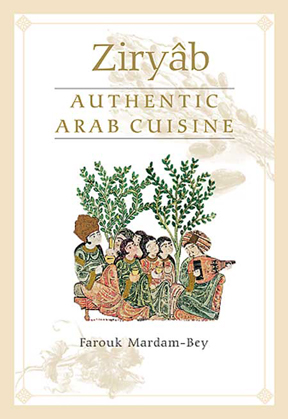
For both a delightful read and a handy recipe book I suggest Ziryab: Authentic Arab Cuisine by Farouk Mardam-Bey and illustrations by Odile Alliet. This was published in 2002 by Ici La Press.
Here is a selection from the foreword:
Abu al-Hasan ‘Ali ibn Nafi’ was born in Iraq in 789 C.C. His family, however most likely originated in Persia. With a melodious voice, dark skin, and gentle manners, he was nicknamed Ziryab, the name of the harmoniously mellow black bird. He received a solid education in the humanities and sciences, especially in geography and astronomy, and eventually became the favorite disciple of Ishaq al-Mawsili, the Abbasid court’s most famous musician and singer. Nevertheless, resentment replaced the preferential treatment he received by his master Ishaq al Mawsili who became envious of Ziryab’s immense success with the great caliph Harun al Rashid to whom he had introduced his protègè. As a result, Ziryab had to leave his country when he was just thirty years old.
So Ziryab traveled west to pursue his fame and fortune, and after a short stay in Tunisia, he eventually settled in Cordoba in 822 C.E. His arrival in Spain could not have been more perfectly timed as the emir ‘Abd al-Rahman’ had recently lost his father, and the new Umayyiad caliph wished to compete with the Baghdadi sultans in extravagance and refinement. Subsequently, the immigrant was received with the highest regards. He was awarded a very generous pension, along with the frequent special bonuses and the rent of several houses and orchards. His musical talent, his encyclopedic knowledge and the utmost distinction of his manners soon captivated the prince, and charmed the whole of Muslim Spain.
Ziryab was an innovator in music. Despite the fact that he was a Middle Easterner himself, he founded what was then known as the Andalusian School of Music. He invented the five-string lure and imposed the use of eagle claw plectrums. Above all, he was an advocate for a new art of living, the successor of Petronius and the predecessor of Brummel as told by Evariste Lèvi-Provencal, one of the most illustrious historians of Spanish Islam.
Ziryab first taught the people of Cordoba the most elaborate recipes of Baghdad’s cuisine, as well as the sequence of plates for an elegant meal. It was no longer acceptable to serve the dishes together; they had to start with soups, then meat, followed by exquisitely spiced fowl dishes, and finish with sweets, walnuts, almonds, and honey cakes, or vanilla-flavored preserved fruits filled with pistachios and hazelnuts. He wanted the aroma of the food to send the saliva under the tongue, and the sight of the table to bring pleasure to the eye. As for tablecloths, he did away with coarse linens and replaced them with fine leather; he proved that precious crystal stem-glasses suited the table setting better than gold or silver goblets. His innovations in the esthetics of living culminated in the opening of an institute of beauty in Cordoba, where people could learn the art of make-up, how to wax their body-hair, how to use tooth paste, and even how to style their hair. He instructed individuals to have their hair cut short and round, uncovering their eyebrows, the napes of their necks, and their ears, instead of keeping their hair long and allowing their parted hair to fall sloppily over their foreheads and temples. He established a fashion calendar which decreed that people should dress in white from early June through late September, and that Spring would be the season for light silk gowns and bright colored tunics, and the winter time for quilted cloaks and fur coats. People sought his advice, and followed it word for word. The influence of the delicate and elegant ‘Abbasid culture could not have been more direct, or more profound. Under Ziryab’s unchallenged leadership, both courtiers and city-dwellers transformed the way individuals dressed, furnished their houses, and cooked their meals. Even many centuries later, the Arabic Petronius’ name could be heard every time a new fashion appeared in the salons of the Spanish peninsula.